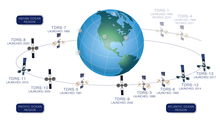TDRS-9
[4] It was the second Advanced TDRS, or second-generation Tracking and Data Relay Satellite, to be launched.
At 06:00 on 6 October, following a series of apogee burns, it reached geostationary orbit.
[6] The orbit raising maneuvers were originally scheduled to take ten days, but ended up lasting six months due to a problem with the system used to pressurize its number two fuel tank.
[7] Upon reaching geostationary orbit, TDRS-I was initially placed at a longitude 151 degrees west of the Greenwich Meridian, and following on-orbit testing it received its operational designation, TDRS-9.
[8] Engineers believed that the problems with its fuel tank pressurization system would not affect its operational lifespan.


